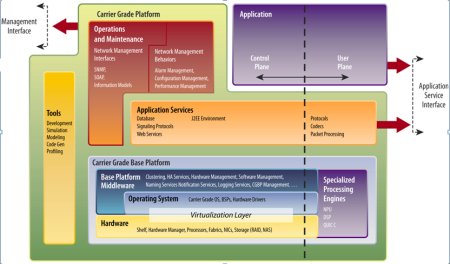Linux-based telecom platform boasts in-service upgrades
Jun 16, 2008 — by Eric Brown — from the LinuxDevices Archive — 9 viewsEnea announced version 2.0 of its Linux-based Enea Accelerator Platform for IP-based services built on carrier-grade infrastructure. The soup-to-nuts platform now offers support for “fine-grain in-service software upgrades” for mixed-application version upgrades, says the Swedish software company.
Underpinning the upgrade is the shipment of version 3.0 of Enea's high-availability middleware Element, which is designed for heterogeneous telecom environments that mix Linux with Enea's own OSE and OSEck real-time operating systems (RTOSes). Element 3.0 boasts support for the Availability Management Framework (AMF) defined by the Service Availability Forum (SAForum or SAF), along with in-service upgrades and optional DSP (digital signal processor) management add-ons. The SAF support includes new redundancy models, fail-over modes, and health monitoring capabilities, says Enea.

A simplified architecture diagram for Enea Accelerator 2.0.
Enea can provide “90 to 95 percent” of components in the green box,
says Enea, including user applications to the right of the dotted line.
(Click to enlarge)
Accelerator is designed for IP-based services including broadband access, VoIP, IPTV, gaming, and streaming video. It is optimized for Wind River's Carrier Grade Linux (CGL) distribution, as well as the default CGL distro, MontaVista Linux Carrier Grade Edition, which Enea has resold since April 2006. The platform is available with out-of-the-box Kontron ATCA systems, and is also compatible with Radisys equipment. In addition to Element and Linx, the platform includes a variety of network protocols, a database, and embedded- and DSP management software. Components include Enea's Polyhedra high-performance database system and Tail-f's ConfD software configuration management toolset, which is now fully integrated in Accelerator, says Enea.
In-service upgrades tap SAF technology
With the release of Enea Accelerator 2.0, the platform's in-house and third-party software has been upgraded to support Element 3.0's in-service upgrade capability. This includes version 2.0 of the Linx inter-process communications (IPC) services package, which was announced last week. Linx 2.0 adds protocol/feature negotiation and priority messaging, in addition to supporting Element's in-service features.
The SAF AMF framework is the key to the in-service capability, says Enea. AMF enables an Element cluster to transition from an active set of releases applied on each node in the cluster to a new set of releases — without having to stop and restart the whole cluster. Service providers can now selectively load and restart individual software components, which Enea says improves service availability and simplifies system maintenance.
“Users can upgrade on a running system without a loss of service,” said Chris Lanfear, Enea's director of Product Marketing, in an interview. According to Lanfear, service and maintenance typically represents over a third of all downtime. “The telecom industry has been good at dealing with faults, so a system will shut down or fail to another system if there's a problem, but no one has provided a commercial, third-party in-service upgrade,” he said. “Cisco and Juniper have built their own versions in-house, but this is the first third-party generic capability.”
Element 3.0 architecture
(Click to enlarge)
Accelerator 2.0 also features the full integration into Element of Enea's previously announced dSpeed technology for monitoring and debugging DSP farms. dSpeed supports DSP management processors running Linux, and works with DSP clusters based on Enea's OSEck RTOS for DSPs. dSpeed is said to extend Element control plane management facilities to the user plane, providing fine-grain debug, management, and control over data plane blades equipped with high-density DSP farms. The software provides detection, DSP core isolation, recovery, coordinated restart, and notification features for containing and repairing DSP failures, says the company.
“DSpeed can now generate event notification through Element, so you can manage the entire system through a single piece of software,” said Lanfear. “It can also go beyond DSPs to manage [Cavium] Octeons and other multicore devices, so it's pretty extensible.”
dSpeed architecture
(Click to enlarge)
As part of its support for SAF, Enea now offers HPI (Hardware Platform Interface) shelf management interface software from Pigeon Point Systems. HPI is an abstracted interface for managing computer hardware, such as chassis and rack based servers. Finally, Accelerator has added support for ATCA/AMC-based DSPs and PowerPC hardware from Embedded Planet and Mercury Computer, says the company.
Future directions for Enea include extending its reach into application development and professional services, said Lanfear, especially in regard to supporting higher-level networking protocols. “We need to improve our support for next-generation-network protocols, such as SIP and Diameter,” said Lanfear. Toward that end, in April the company acquired a French supplier of portable protocol stacks called Netbricks. “We are looking at how we can integrate these protocols into Accelerator, so that companies can build applications on top of that,” added Lanfear. In May, meanwhile, Enea acquired IP Devel, a Romanian company specializing in embedded systems development and advanced test services.
While much of Enea's focus in recent years has been on Linux, the company's proprietary RTOS, called OSE, is still the company's primary business. OSE is deployed in the software-defined baseband radios of approximately half of the world's 3G mobile phones and base stations, says the company.
Availability
Enea Accelerator 2.0, including Element 3.0, will be available by the end of the month, says Enea.
This article was originally published on LinuxDevices.com and has been donated to the open source community by QuinStreet Inc. Please visit LinuxToday.com for up-to-date news and articles about Linux and open source.